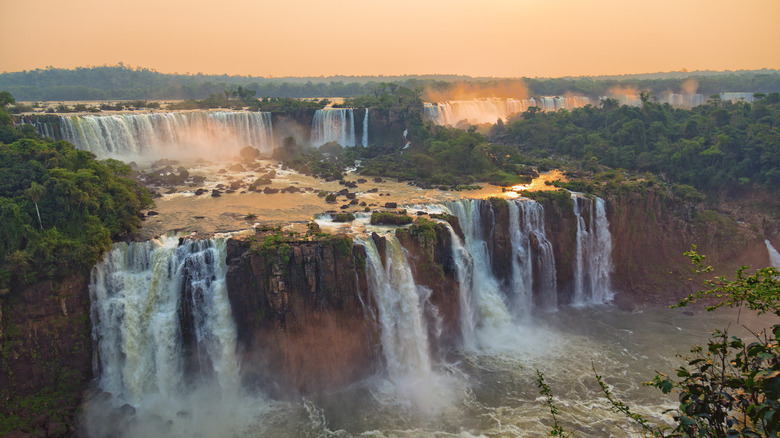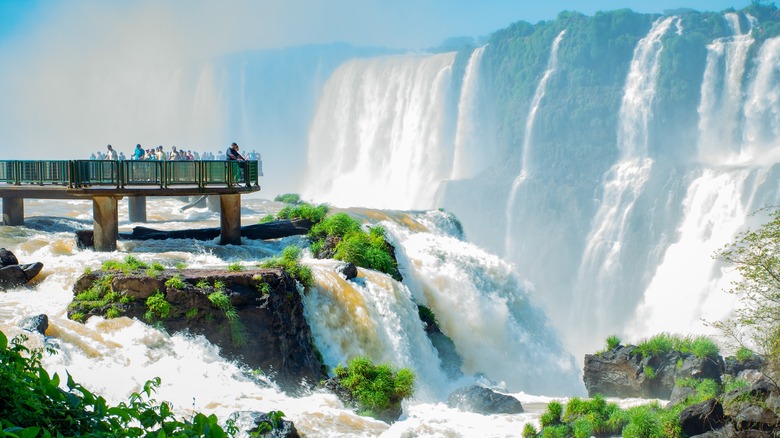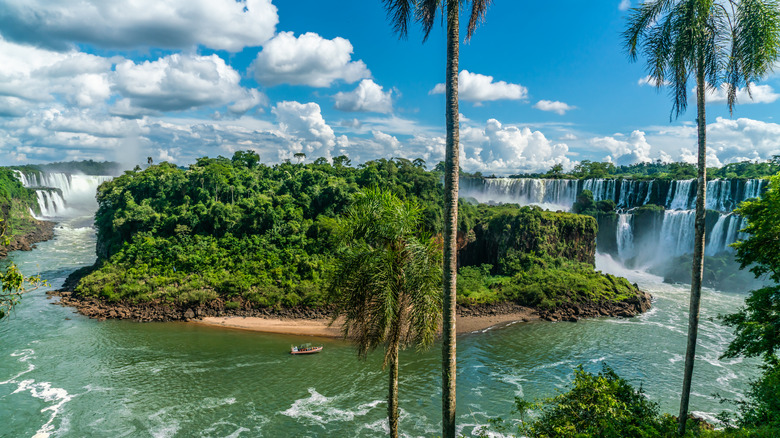Situated Between Brazil And Argentina Is The World's Largest Waterfall System With Jaw-Dropping Landscapes
The thundering roar of the water, the haze of the misty spray, and natural beauty at its finest — once you set your eyes on the Iguazú Falls, no other sight can ever compare. Keep in mind, although Brazilians, who speak Portuguese, refer to the falls as "Iguaçu," Argentinians and other parts of the world use the Spanish spelling "Iguazú." This is what a truly magnificent waterfall system looks like, with approximately 275 different cascades tumbling down into the Paraná River. As the largest of its kind in the world, Iguazú makes the Niagara and Victoria Falls seem insignificant in size. It spans the border between Argentina and Brazil, South America's largest country, famed for its beaches, rainforests, and city life. You can marvel at the waterfall in both countries — each comes with a unique vantage point of the jaw-dropping spectacle.
Around 130 million years ago, constant volcanic activity resulted in the Paraná Plateau, which extends over Brazil, Paraguay, and Argentina. While the plateau is composed of basaltic rock, a bed of sandstone and sedimentary rocks blankets the surface. Due to this feature, the Iguazú River — a key tributary of the Paraná— wore down the cliffs over the years, creating a series of cascades. Since erosion is a continuous process, the waterfalls end up changing every time you see them — some might be larger, some smaller. Each individual waterfall within the system is anywhere from 197 to 269 feet. With dense rainforest greenery amping up the waterfalls' fullness, you can't help but be amazed by how alive Iguazú feels.
The sheer number of vertical flows in Iguazú makes it a visual overload in the best possible way. However, you'll immediately spot the 269-foot, semicircular Devil's Throat (or Garganta do Diabo), the crown jewel of Iguazú. Marking the border of Brazil and Argentina, it plunges dramatically into a canyon. Seeing this phenomenon is an absolute bucket-list goal for those vacationing in South America.
Visiting Iguazú Falls in Brazil
For the ultimate experience, head to the Iguazú Falls between April and May or September and October to avoid the high temperatures — bonus points if you go during the week. Given the size of Brazil, it's better to fly there, as the drive from São Paulo takes over 13 hours. The city of Foz do Iguaçu is your gateway — you'll land in Foz do Iguaçu International Airport, about 30 minutes from the natural wonder. From here, make your way to Iguazú National Park. While its Argentine counterpart hosts more tourists, the Brazilian side is significantly larger.
Iguazú National Park provides all the amenities necessary for a comfortable visit — lockers, ATMs, parking lots, and more. Make sure to have bug spray and a raincoat with you. If you haven't booked your tickets, buy them at the entrance, then take the bus that brings you to the trail. The paved path in the park leads you to several lookouts, where you can admire the striking panorama. Although it's short — almost one mile long — it can take a while to complete, considering all the stops you'll be making along the way. Watch out for giant otters, anteaters, and toucans while you're at it. When you see the metal walkway, make sure to get to the end to be as close as possible to Garganta do Diabo.
Another unforgettable way to witness Iguazú is by going on a helicopter ride. Helisul offers a couple of packages — flights can be as quick as 10 minutes or 30 minutes. Boating and whitewater rafting in Iguazú are just as exciting, but prepare to get soaked. True daredevils, however, will immediately go for abseiling and feel right in the heart of the action.
Chase waterfalls in Argentina's Iguazú National Park
Puerto Iguazú serves as the base of your adventures in Argentina. To get to the city, you'll most likely fly into Cataratas del Iguazú International Airport, which is about 30 minutes away. It's another 30 minutes getting to Iguazú National Park from the center. The good news is that, despite being the smaller of the two, this national park boasts more trails, and the greater part of the waterfalls are located on this side.
Upon purchasing your ticket, follow the Superior Circuit, guiding you to multiple iconic cataracts, such as Chico, Mendez, and Mbiguá Falls. You also get vistas of the Brazilian side from this trail. The Lower Circuit, on the other hand, exposes you to the lush vegetation before the Devil's Throat begins to come into view. As for hikes that are as unspoiled as they come, the Macuco Trail is a rugged route where you can observe the local flora and fauna. Perhaps the coolest activity here is the Rainforest Ecological Train ride (included in your ticket), running along the jungle and toward the Devil's Throat station — the pathway opens up to stunning scenery of the largest waterfall within the system.
Gran Aventura offers fun eco-truck and boat trips so you can get up close and personal with the waterfalls. If your visit falls on a new moon, you're in luck — the night tour is a must-do, providing a whole new perspective of Iguazú. Of course, helicopter excursions are available on this side, too. Experiencing the Iguazú Falls from Brazil and Argentina is worthwhile, especially knowing that both countries are some of the best vacation destinations where the U.S. dollar goes furthest. Cheap and rich? Yes, please.


